Dry Rot Guide: Identification, Costs & Treatment Options

Dry rot is a destructive wood-destroying fungus, primarily Serpula lacrymans, that can rapidly compromise your home’s structural integrity. Unlike other molds, dry rot can transport moisture up to 5 meters through its mycelium network, allowing it to attack even dry wood and spread throughout buildings undetected.
As Ontario and Quebec’s trusted mold removal professionals, we are receiving an increasing amount of requests from homeowners in the Montreal, Gatineau and Ottawa areas regarding dry rot.
⚠️ Health & Safety Alert
While dry rot fungi don’t directly cause respiratory illness like toxic molds, they create serious health risks:
- Structural collapse hazards from weakened support beams
- Indoor air quality degradation from spore release
- Secondary mold growth in damaged, moisture-rich areas
- Increased allergen levels for sensitive individuals
The concerns of our clients are legitimate. Dry rot, also called cubic or fibrous rot, is one of the last things you want to find in your home. More than any other fungus, dry rot has an unparalleled ability to destroy wood, eating away at building structures much faster than any other mold.
Worried About Dry Rot? Get a Free Inspection!
Dry rot can severely damage your home’s structure and is often difficult to detect. Don’t let it go unchecked! Contact Mold Busters for a free virtual mold inspection. Our experts are ready to provide you with a comprehensive assessment and a plan to tackle any mold issue, ensuring your home is safe and healthy. Act now to protect your space!
What is dry rot?
Dry rot is a wood-destroying fungus that feeds on cellulose and lignin in timber, causing structural decay. The term refers to several fungal species, with Serpula lacrymans being the most destructive in North American climates.
Dry rot is a common synonym for wood decay, but the term actually refers to a wide variety of fungi, all of which share a common characteristic–their love of wood. They feed off of the cellulose and humidity found in wood until it decays.
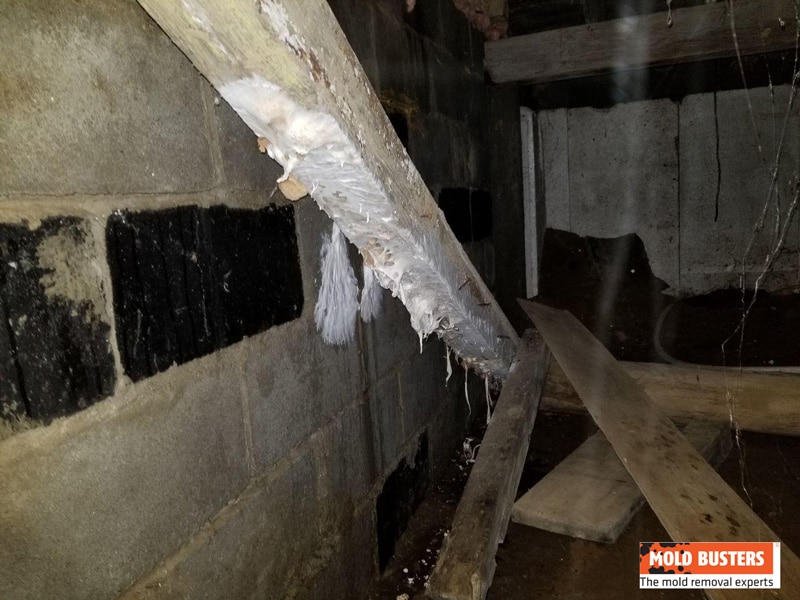
📊 Did you know?
Only 8% of basements we have tested didn’t have presence of mold?! Find out more exciting mold stats and facts inside our mold statistics page.
The appearance of these fungi varies significantly between species. Most of them, however, are orange, brown or yellow, and are accompanied by grey mycelia that can extend several metres.
Two Main Species Found in Canadian Buildings:
- Meruliporia incrassata: Common on Pacific coast
- Serpula lacrymans: Most destructive, common in Ontario and Quebec’s temperate climates
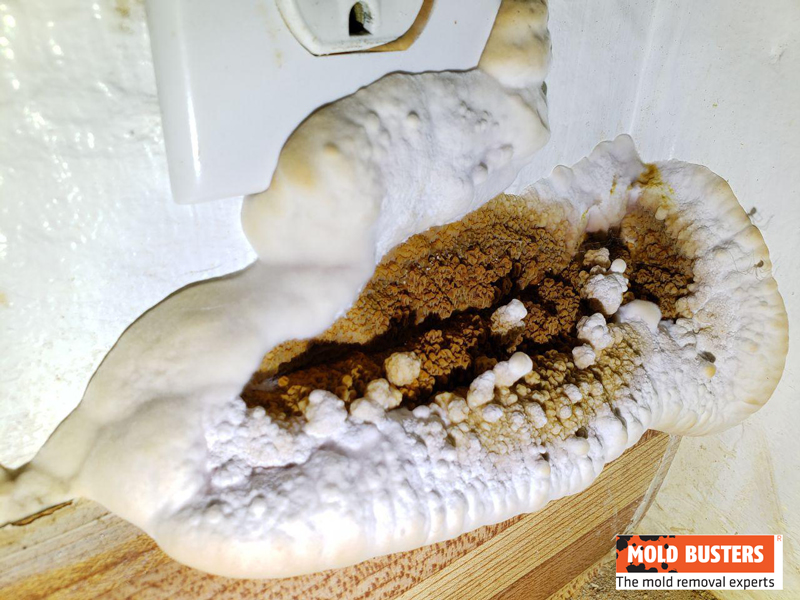
Serpula Lacrymans
Like all fungi and mold, dry rot needs moisture to grow, which makes its name somewhat misleading. However, it has the special ability to drain this water far away from the area that it has colonized, thanks to its mycelium, which can be more than 5 metres long and extend over non-organic surfaces like ceramic tile and concrete. Dry rot can thus contaminate and destroy even dry wood, hence its name.
How to Identify Dry Rot in Your Home
Dry rot identification requires checking for cuboidal cracking patterns, orange-brown spore dust, cotton-wool mycelium, and a distinctive musty odor. Professional moisture testing reveals 20-30% wood moisture content optimal for fungal growth.
Proper identification of dry rot is crucial for preventing extensive structural damage. Our professional mold inspection services use advanced detection methods, but homeowners can learn to recognize early warning signs.
What Does Dry Rot Look Like in Wood?
Dry rot appears as distinctive cuboidal cracking patterns that create a checkerboard appearance in infected wood. The timber becomes brittle, lightweight, and crumbles when touched, often accompanied by orange-brown dust spores.
🔍 Visual Indicators:
- Cuboidal cracking: Square-shaped cracks creating checkerboard pattern
- Brittle texture: Wood becomes lightweight and breaks easily
- Color changes: Timber darkens to brown or grey
- Spore dust: Orange-brown powdery residue
- Mycelium growth: White to grey cotton-wool like strands
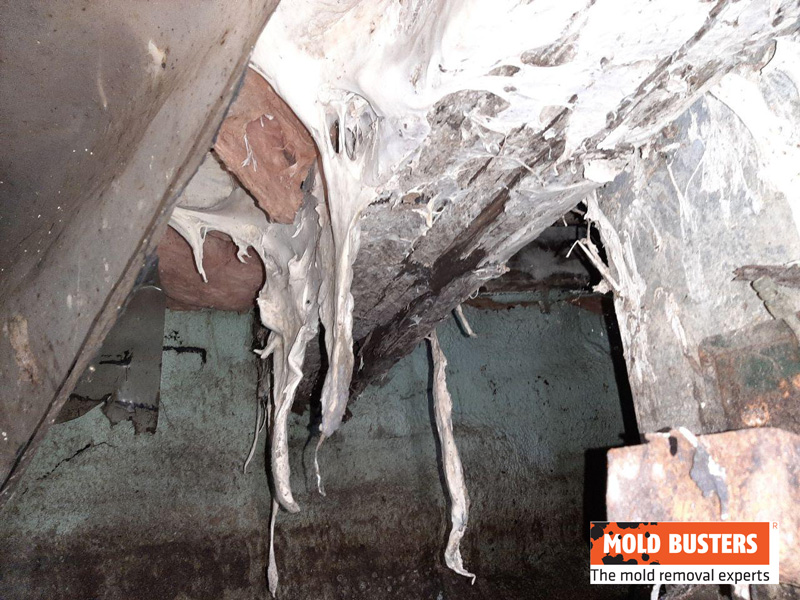
Advanced dry rot showing characteristic visual signs
How to Tell the Difference Between Dry Rot and Wet Rot
Dry rot can spread to dry wood through mycelium networks up to 5 meters long, while wet rot requires constant moisture at the infection site. Dry rot creates cuboidal cracking; wet rot causes longitudinal splitting along wood grain.
🟠 Dry Rot Characteristics:
- Spreads through mycelium across dry surfaces
- Creates cuboidal cracking patterns
- Produces orange-brown spore dust
- Can attack wood with moisture content below 20%
- Primarily caused by Serpula lacrymans
🔵 Wet Rot Characteristics:
- Requires constant moisture at infection site
- Causes longitudinal cracking along grain
- Produces darker, often black discoloration
- Cannot spread to areas without moisture
- Multiple species including Coniophora puteana
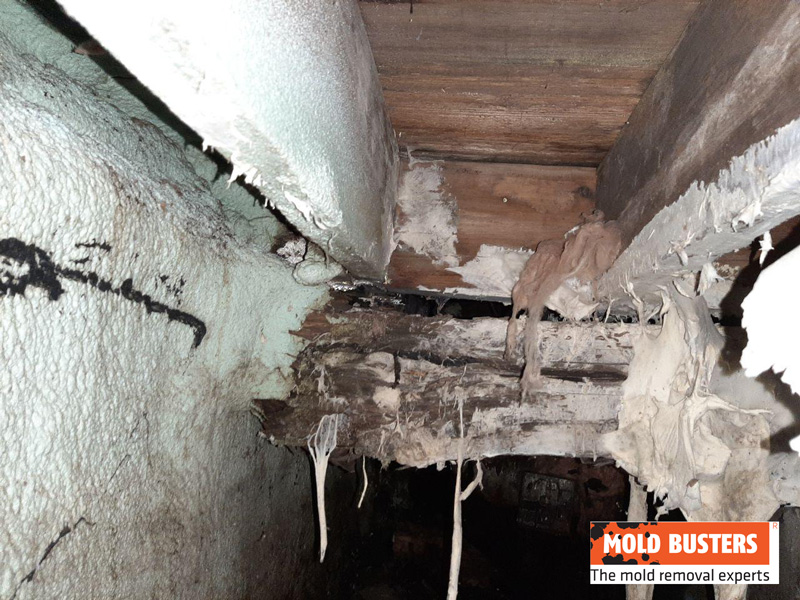
Dry rot damage showing structural impact on support joists
Is Dry Rot Dangerous to Human Health?
Dry rot poses health risks through respiratory irritation from airborne spores, structural collapse hazards from weakened beams, and secondary mold growth in damaged areas. While not directly toxic like black mold, professional assessment is recommended for safety.
Direct Health Impacts:
- Respiratory irritation: Spore inhalation can trigger asthma and allergic reactions
- Skin sensitivity: Direct contact may cause dermatitis in sensitive individuals
- Eye irritation: Airborne spores can cause watering and redness
- Compromised immunity: Elderly and immunocompromised individuals face higher risks
🏠 Indirect Safety Hazards:
- Structural collapse risk: Weakened beams and joists can fail without warning
- Secondary mold growth: Creates conditions for toxic black mold development
- Indoor air quality degradation: Musty odors and increased humidity levels
- Property damage: Can destroy load-bearing elements within months
The most significant health risk comes from structural failure rather than direct fungal toxicity. Our inspection services include structural safety assessment to identify immediate hazards.
What Causes Dry Rot in Homes?
Dry rot develops when three conditions align: temperatures between 3-26°C (optimal at 20°C), wood moisture content above 20%, and poor ventilation trapping fungal spores. Leaks, condensation, and high humidity create ideal growth conditions.
🌡️ Environmental Conditions for Dry Rot Growth:
- Optimal temperature range: 3°C to 26°C with peak growth at 20°C
- Adequate moisture: Wood moisture content above 20% for initial infection
- Organic material: Cellulose and lignin in timber provide nutrients
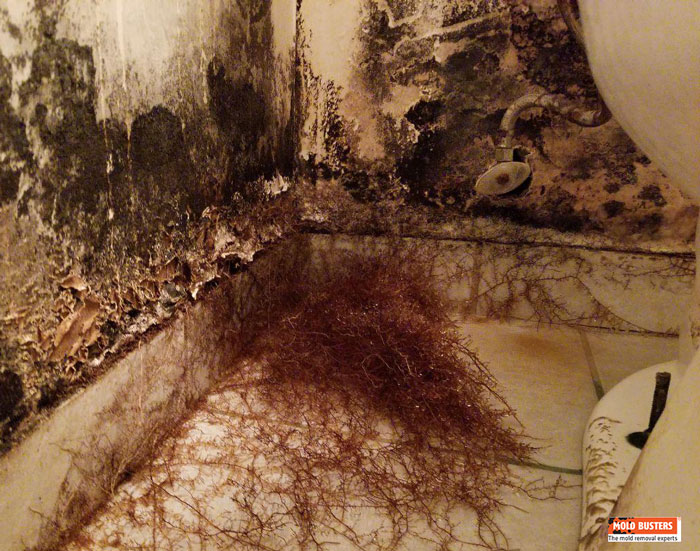
Mycelium growth spreading across infected surfaces
Common Moisture Sources in Canadian Homes
🇨🇦 Ontario & Quebec Climate Risks:
- Seasonal condensation: Temperature fluctuations between heated interiors and cold exteriors
- Spring thaw flooding: Basement moisture from snowmelt and ground saturation
- Summer humidity: High outdoor humidity infiltrating poorly ventilated spaces
- Plumbing leaks: Continuous moisture from failed pipes, fixtures, or appliances
- Roof damage: Water intrusion from damaged shingles, gutters, or flashing
Poor ventilation compounds these moisture issues by preventing air circulation that would naturally dry damp areas. Basements and attics face particular risk due to limited airflow and temperature control.
Where to Look for Dry Rot in the House
Dry rot most commonly develops in basements, attics, and areas near plumbing where poor ventilation combines with moisture exposure. Check timber near bathrooms, kitchens, foundation walls, and roof areas for early signs.
🏠 Basement and Foundation Areas:
- Floor joists and support beams
- Sill plates and foundation contact points
- Areas around water damage or previous flooding
- Poorly ventilated storage areas
🏘️ Attic and Roof Spaces:
- Roof trusses and ceiling joists
- Areas around roof leaks or ice dams
- Poorly insulated or ventilated spaces
- Timber near chimney and vent penetrations
🚿 Bathroom and Kitchen Areas:
- Floor joists under bathrooms and kitchens
- Wall framing behind tile and fixtures
- Areas around plumbing leaks
- Poorly ventilated spaces with high humidity
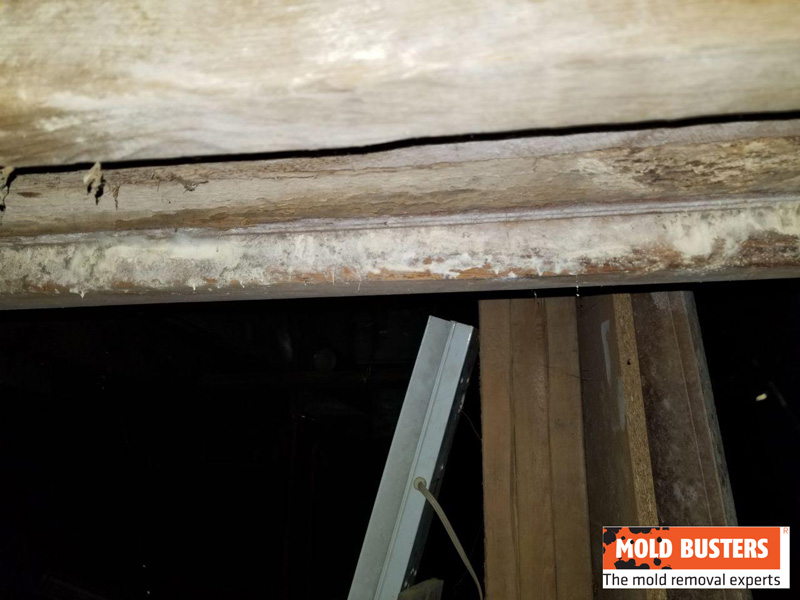
Fungal growth affecting structural joists in basement
Professional inspection becomes essential when visual access is limited. Our infrared inspection services can detect moisture patterns and temperature variations indicating hidden dry rot activity.
Dry Rot Impact on Structures
Dry rot weakens load-bearing timber by destroying cellulose fibers, reducing wood strength by up to 50% with only 1% weight loss. Advanced cases can compromise entire building structures, requiring tens of thousands in repair costs.
🏗️ How Dry Rot Compromises Building Integrity:
- Load capacity reduction: 1% weight loss can reduce strength by 50%
- Compression failure: Support posts and beams lose load-bearing capacity
- Flexural weakness: Floor joists develop dangerous sag and deflection
- Connection failure: Joints and fastener areas become compromised

Structural damage from dry rot on load-bearing joist
🚨 Progressive Damage Stages:
- Stage 1 (0-6 months): Surface colonization, minimal visible damage
- Stage 2 (6-18 months): Deep timber penetration, strength reduction begins
- Stage 3 (18-36 months): Structural compromise, safety hazards develop
- Stage 4 (3+ years): Catastrophic failure risk, extensive replacement required
If swift remedial action is not taken, the physical damage can put a tremendous strain on homeowners, especially financially. Serious cases may even run into the tens of thousands of dollars in expenses in order to replace the entire framework and to decontaminate the property to get rid of fungal spores.
How Much Does Dry Rot Treatment Cost?
Dry rot treatment costs range from $500-$2,000 for small areas, $5,000-$25,000 for moderate infestations, and $25,000-$150,000+ for extensive structural damage. Early detection can reduce costs by 60-80% compared to delayed intervention.
- Professional inspection: $300-$800
- Surface antifungal treatment: $500-$1,500
- Single joist replacement: $800-$2,000
- Minor structural repair: $1,200-$3,000
- Basement/crawlspace remediation: $5,000-$15,000
- Attic structural repair: $8,000-$20,000
- Containment and disposal: $2,000-$5,000
- Moisture control systems: $3,000-$8,000
- Complete structural remediation: $25,000-$75,000
- Rebuild with prevention: $50,000-$150,000+
- Temporary housing: $5,000-$15,000
💡 Cost-Saving Strategy: Our free virtual inspection can identify issues early, potentially saving 60-80% on total remediation costs.
💸 Factors Affecting Treatment Costs:
- Infestation extent: Square footage and depth of penetration
- Structural involvement: Load-bearing vs. non-structural elements
- Access difficulty: Confined spaces increase labor costs
- Containment requirements: Preventing spore spread during work
- Building codes compliance: Upgrades required during repair
- Seasonal timing: Emergency service vs. scheduled work
Our price match guarantee ensures competitive pricing while maintaining quality standards. We also offer flexible financing options to help homeowners address urgent safety issues.
How to Prevent Dry Rot in Your Home
Prevent dry rot by maintaining wood moisture content below 20%, ensuring adequate ventilation, repairing leaks promptly, and scheduling annual inspections of vulnerable areas. Proper drainage and vapor barriers provide additional protection.
💧 Primary Moisture Prevention:
- Repair all leaks immediately: Plumbing, roofing, and foundation issues
- Improve drainage: Grade soil away from foundation, clean gutters regularly
- Install vapor barriers: In crawl spaces and basement areas
- Monitor humidity levels: Maintain below 60% throughout home
🌀 Ventilation Improvements:
- Basement ventilation: Install exhaust fans and dehumidifiers
- Attic airflow: Ensure proper soffit and ridge ventilation
- Bathroom/kitchen ventilation: Use exhaust fans during and after moisture activities
- HVAC optimization: Regular maintenance for consistent air circulation
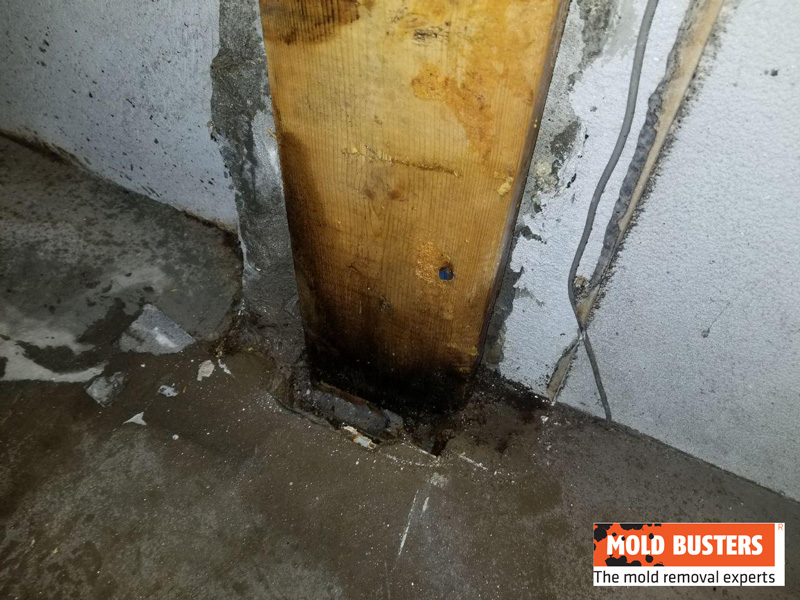
Water damage prevention reduces dry rot risk
Regular Inspection Schedule
📅 Systematic Inspection Timeline:
- Monthly checks: Visible wood surfaces in basements and attics
- Seasonal inspection: After spring thaw and before winter heating
- Annual professional assessment: Hidden areas requiring specialized equipment
- Post-event inspection: After flooding, leaks, or significant weather events
Our professional inspection services include detailed reporting on risk factors and recommendations for preventive measures specific to your property.

Early identification prevents extensive damage
Professional Dry Rot Treatment Methods
Professional dry rot treatment involves structural assessment, moisture source elimination, infected material removal, antifungal treatment, and replacement with treated lumber. Containment prevents spore spread during remediation work.
🔍 Phase 1: Assessment and Planning
- Structural safety evaluation
- Extent mapping using moisture meters and thermal imaging
- Spore sampling for species identification
- Treatment scope and cost estimation
🛡️ Phase 2: Containment and Safety
- Work area isolation with negative air pressure
- Personal protective equipment for workers
- HEPA filtration systems
- Safe disposal protocols for contaminated materials
🔧 Phase 3: Remediation and Treatment
- Infected material removal beyond visible damage
- Structural repair and reinforcement
- Antifungal treatment of surrounding areas
- Moisture source elimination
🚀 Phase 4: Prevention and Monitoring
- Installation of moisture control systems
- Preventive treatment application
- Air quality verification testing
- Follow-up inspection scheduling
Our state-of-the-art equipment enables precise treatment while minimizing disruption to occupied spaces.
🔬 Advanced Treatment Technologies:
- Thermal treatment: Controlled heat application for localized sterilization
- Borate injection: Deep timber penetration with long-lasting protection
- Structural reinforcement: Steel and engineered lumber supplementation
- Environmental controls: Dehumidification and ventilation systems
Before and After: Real Case Study
Checkout our real case dry rot remediation work in residential building by comparing the before and after photos:
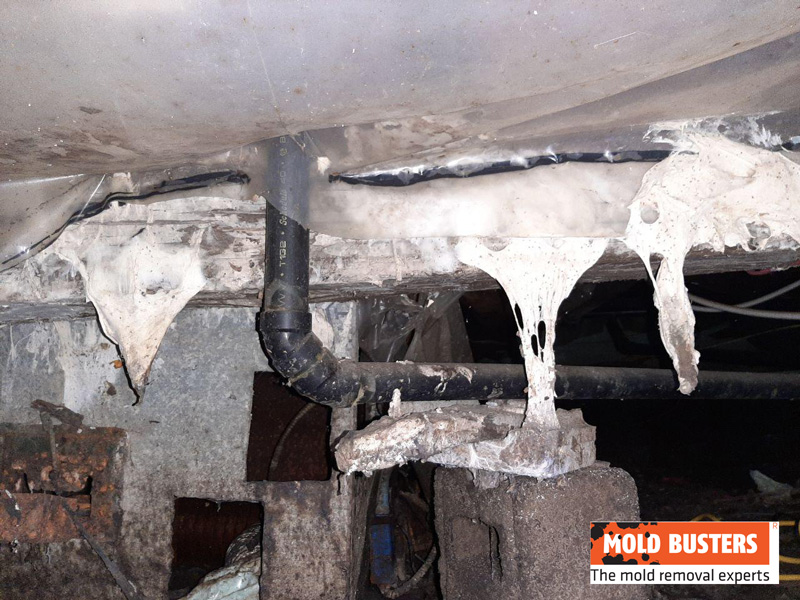
Dry rot in crawlspace – before treatment
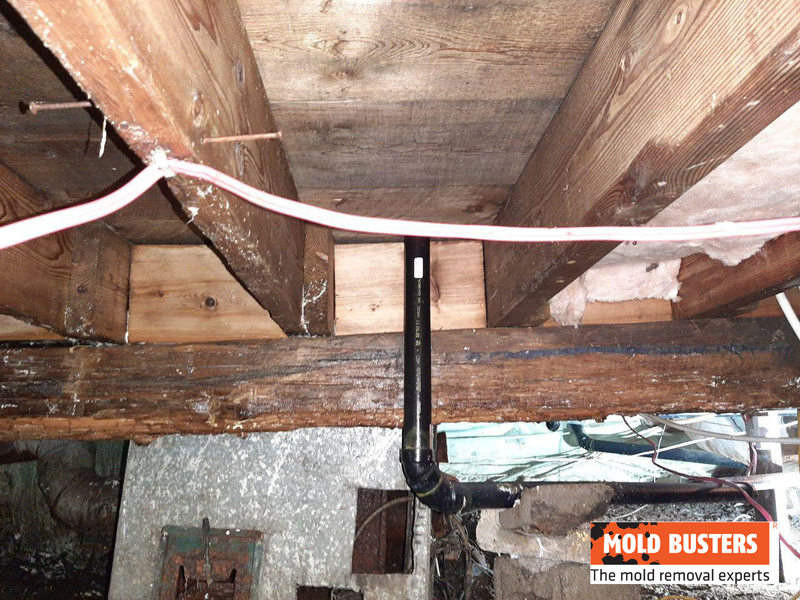
Dry rot in crawlspace – after treatment
DIY Dry Rot Treatment vs Professional Services
DIY treatment works for surface areas under 1 square foot, but professional services are essential for structural elements, extensive damage, or when safety risks exist. Improper DIY treatment often leads to recurring problems and higher costs.
✅ DIY-Suitable Conditions:
- Surface-level infection under 1 square foot
- Non-structural wood elements
- Easy access without confined space entry
- No electrical or plumbing proximity
- Recent detection with minimal penetration
⚠️ Professional Required:
- Load-bearing structural elements affected
- Infection area exceeds 1 square foot
- Multiple locations or hidden damage
- Confined space work in crawlspaces or attics
- Electrical, plumbing, or HVAC systems involved
- Previous treatment failures
- Health concerns for occupants
🛠️ DIY Treatment Methods and Safety:
- Safety first: N95 masks, eye protection, gloves, ventilation
- Containment: Plastic sheeting to prevent spore spread
- Removal: Cut infected wood 12+ inches beyond visible damage
- Treatment: Apply borate-based fungicides to surrounding areas
- Replacement: Use pressure-treated or naturally resistant lumber
Common DIY mistakes include inadequate removal, insufficient treatment of surrounding areas, and failure to address moisture sources. These errors often result in recurrence and higher ultimate costs.
Professional assessment after DIY treatment provides verification and peace of mind. Our air quality testing services can confirm treatment effectiveness.
Frequently Asked Questions About Dry Rot
Yes, dry rot spreads rapidly through buildings via mycelium networks extending up to 5 meters. Serpula lacrymans can transport moisture and nutrients across non-organic surfaces like concrete and masonry to colonize new wood sources throughout structures.
Under optimal conditions (20°C, adequate moisture), visible dry rot appears within 2-6 months. Significant structural damage typically occurs over 6-24 months, depending on environmental conditions, wood type, and fungal species involved.
DIY treatment works for surface infestations under 1 square foot on non-structural elements. However, most dry rot cases require professional assessment due to potential structural damage and difficulty determining the full extent of fungal spread.
Coverage depends on the underlying cause of moisture leading to dry rot. Damage from sudden, covered events (burst pipes, storm damage) often receives coverage, while long-term moisture issues or maintenance failures typically face exclusion.
Ontario and Quebec law requires disclosure of known dry rot issues to potential buyers. Active dry rot typically reduces property value by 10-25%. Professional remediation before listing often yields better net proceeds despite upfront costs.
Dry rot transports moisture long distances and attacks dry wood; wet rot requires constant moisture at infection sites. Dry rot creates cuboidal cracking patterns while wet rot causes longitudinal splitting along wood grain. Dry rot is generally more destructive.
Quebec Financial Aid for Dry Rot Removal
Quebec’s residential dry rot intervention program provides up to $75,000 for partial losses and $100,000 for total rebuilding, covering 75% of recognized costs. Eligible homeowners must live in the property as primary residence and follow SHQ application procedures.
✅ Eligibility Requirements:
- Owner-occupants only: Must live in property as primary residence
- Property types: Single-family homes, duplexes, triplexes, townhomes, some mobile homes
- Utilities required: Independent sanitary installation or running water
- Exclusions: Tenants, non-occupying owners, purely commercial properties
💰 Financial Assistance Levels:
- Partial losses: 75% of costs up to $75,000 maximum
- Total losses (demolition/rebuild): 75% of costs up to $100,000 maximum
- Assessment costs: 100% coverage for contamination reports and technical specifications
- Professional fees: Full coverage for required expert consultations
📋 Application Process:
- Initial application: Submit eligibility form to SHQ
- Professional assessment: Certified environmental specialist confirms dry rot presence
- Technical evaluation: Building specialist creates detailed scope of work
- Contractor selection: Obtain quotes from minimum two qualified contractors
- Work authorization: SHQ issues certificate of eligibility
- Progressive payments: Invoices submitted for scheduled reimbursements
- Final inspection: Completion verification before final payment
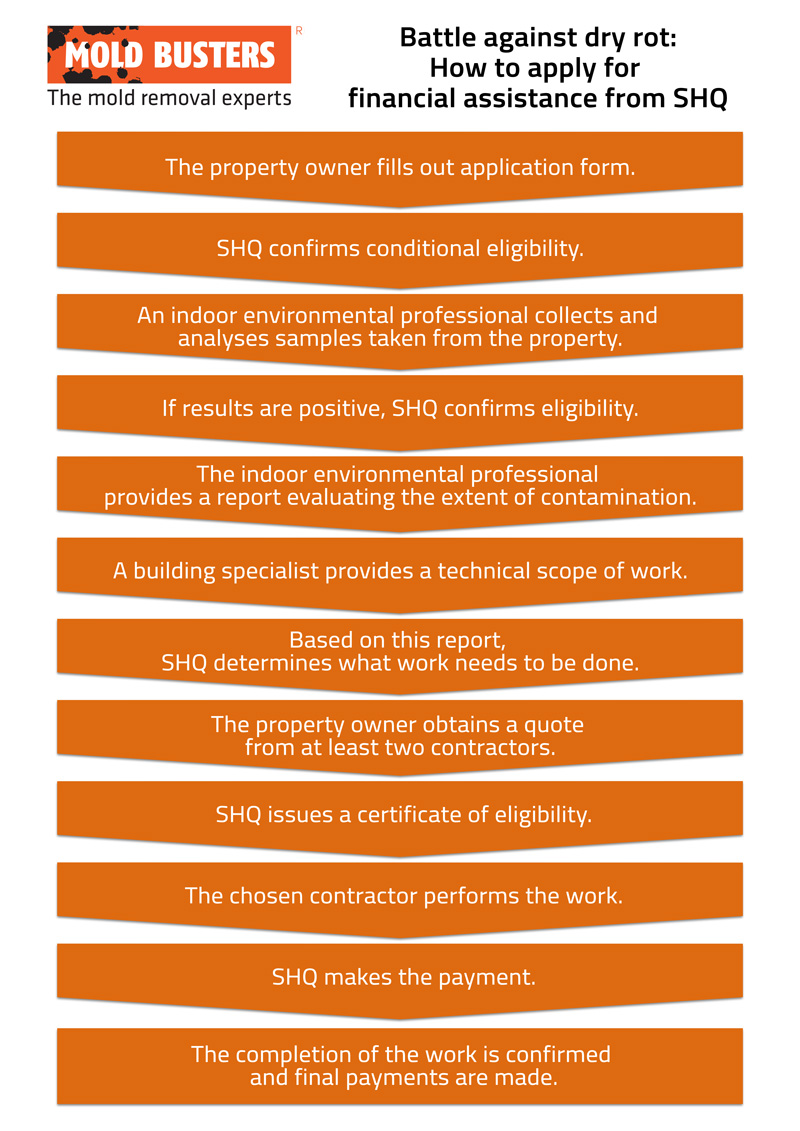
Quebec dry rot financial aid program summary
💡 Program Tip: Early detection and application maximize your chances of approval and reduce out-of-pocket expenses. Our free virtual inspection can help identify qualifying conditions.
Our experience with SHQ program requirements ensures smooth application processing and compliance with all certification standards. We provide comprehensive documentation supporting your eligibility and treatment needs.
🏠 Protect Your Home from Dry Rot
Don’t let dry rot compromise your family’s safety and your property’s value. Our certified professionals provide comprehensive assessment, treatment, and prevention services throughout Ontario and Quebec.
🔍 Get Immediate Help:
- Free virtual inspections available
- 24/7 emergency response
- Same-day reports and estimates
- Certified, experienced technicians
💼 Professional Services:
✅ Certified Professionals
IICRC certified technicians with specialized dry rot training and 15+ years experience
🔬 Advanced Equipment
State-of-the-art thermal imaging, moisture detection, and remediation technology
📋 Comprehensive Service
From initial inspection through complete remediation and prevention planning
💰 Financial Solutions
Flexible financing options and assistance with Quebec SHQ program applications
📚 Related Resources and Services
Inspection Services:
Remediation Services:
Related Mold Types:
📍 Service Areas
Proudly serving dry rot inspection and remediation throughout:
Ready to Eliminate Dry Rot from Your Home?
Don’t let dry rot compromise your family’s safety and your home’s structural integrity. Contact Mold Busters today for professional assessment and treatment.
🔍 Free Virtual Inspection
Get expert assessment from the comfort of your home
Schedule Virtual Inspection📞 Speak with an Expert
Discuss your specific situation with our certified professionals
Contact Us TodayDisclaimer: This information is provided for educational purposes and should not replace professional assessment. Dry rot identification and treatment should always involve qualified professionals due to structural safety concerns. Mold Busters provides expert services in accordance with industry best practices and local building codes.
Copyright: This content is proprietary to Mold Busters and protected by copyright law. Reproduction or distribution without permission is prohibited.
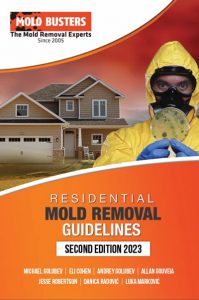
Get Special Gift: Industry-Standard Mold Removal Guidelines
Download the industry-standard guidelines that Mold Busters use in their own mold removal services, including news, tips and special offers:
"*" indicates required fields
Published: September 16, 2019 Updated: August 15, 2025

Written by:
John Ward
Account Executive
Mold Busters
Fact checked by:
Michael Golubev
CEO
Mold Busters
